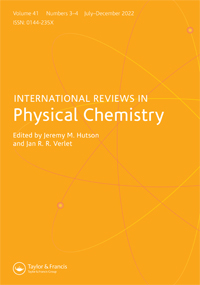原子和分子碰撞和光离/光分离的时间延迟
IF 2.5
2区 化学
Q3 CHEMISTRY, PHYSICAL
引用次数: 8
摘要
值得注意的是,时间延迟是一个实验可测量的量,但时间本身不是。本文综述了量子碰撞和原子与分子系统的光离/光分离中的时间延迟。讨论了波包与目标量子碰撞中时间延迟的Wigner-Eisenbud形式。它的等价与史密斯的时间延迟的形式,基于一个独立的基础上的时间延迟在碰撞区多余的粒子密度,证明了。讨论了电子与正原子/分子离子的量子碰撞与中性原子/分子的光离/光脱离之间的异同,指出了具有出波和入波边界条件的溶液之间涉及时间反转对称性的潜在量子动力学,将光离/光脱离解释为半散射。随后利用这种关系扩展了Wigner-Eisenbud-Smith时间延迟在光电离/光脱离中的形式主义。时间延迟的可测量性是用表征它的自伴随量子算子来解释的,即使时间本身没有这样的算子。本文列举了时间延迟理论和实验研究的几个实例,以说明近二十年来该领域取得的突出进展。本文章由计算机程序翻译,如有差异,请以英文原文为准。
Time delay in atomic and molecular collisions and photoionisation/photodetachment
It is remarkable that time delay is an experimentally measurable quantity, but time itself is not. Time delay in quantum collisions and in photoionisation/photodetachment of atomic and molecular systems is reviewed in this paper. Wigner–Eisenbud formalism of time delay in quantum collision of a wavepacket with a target is discussed. Its equivalence with Smith's formalism of time delay, based on an independent basis for time delay in terms of excess particle density in the collision zone, is demonstrated. Similarity and difference between quantum collision of an electron with a positive atomic/molecular ion and photoionisation/photodetachment of a neutral atom/molecule are discussed, and the underlying quantum dynamics involving the time-reversal symmetry between solutions with outgoing and ingoing wave boundary conditions is pointed out to interpret photoionisation/photodetachment as half-scattering. This relationship is subsequently taken advantage to extend the formalism of Wigner–Eisenbud–Smith time delay in photoionisation/photodetachment. The measurability of time delay is accounted for in terms of a self-adjoint quantum operator that characterises it, even if there is no such operator for time itself. A few illustrative examples of theoretical and experimental studies of time delay are given to indicate outstanding advances made in this field in the last two decades.
求助全文
通过发布文献求助,成功后即可免费获取论文全文。
去求助
来源期刊
CiteScore
14.20
自引率
1.60%
发文量
5
审稿时长
1 months
期刊介绍:
International Reviews in Physical Chemistry publishes review articles describing frontier research areas in physical chemistry. Internationally renowned scientists describe their own research in the wider context of the field. The articles are of interest not only to specialists but also to those wishing to read general and authoritative accounts of recent developments in physical chemistry, chemical physics and theoretical chemistry. The journal appeals to research workers, lecturers and research students alike.

 求助内容:
求助内容: 应助结果提醒方式:
应助结果提醒方式:


